| Article ID | Journal | Published Year | Pages | File Type |
|---|---|---|---|---|
| 617471 | Wear | 2013 | 8 Pages |
•In-situ optical microscopy is introduced to monitor ice surface evolution in rubber friction testing.•No signs of melting for length scales longer than 100 µm.•Ice deformation has a role in explaining ice slipperiness.
The constant need to improve road safety and the driving performance of winter tires imposes challenging requirements on tire development, especially when considering that one of the key steps, the evaluation of the product itself, is limited by the seasonal changes. This explains why the industry is moving towards indoor testing. An example is the ice performance of tires, which is very frequently characterized indoors or even in the laboratory. The quality of the data thus obtained, however, depends strongly on how well the artificial surface approximates real life. Today, several methods are available to assure the consistency of the test data by controlling the creation and the break-in of the ice track used for testing. At the same time what happens at the surface during its preparation and how this affects the physics of the rubber–ice contact is not yet fully understood. To build this understanding, in the work reported here we were focusing on one of the simplest experiments available. Series of linear friction tests were performed in the laboratory with strict environmental and procedural control. The quasi-real-time microstructural monitoring of the ice surface, together with the friction measurements, allowed the main physical processes that were ongoing during the break-in of the fresh or aged ice surfaces and led to changes in the contact conditions to be identified. The results indicated that there was no large-scale melting of the ice when the rubber was sliding over it. The deformation of the ice and its strong dependency on temperature, on the other hand, may play a significant role in ice friction.
